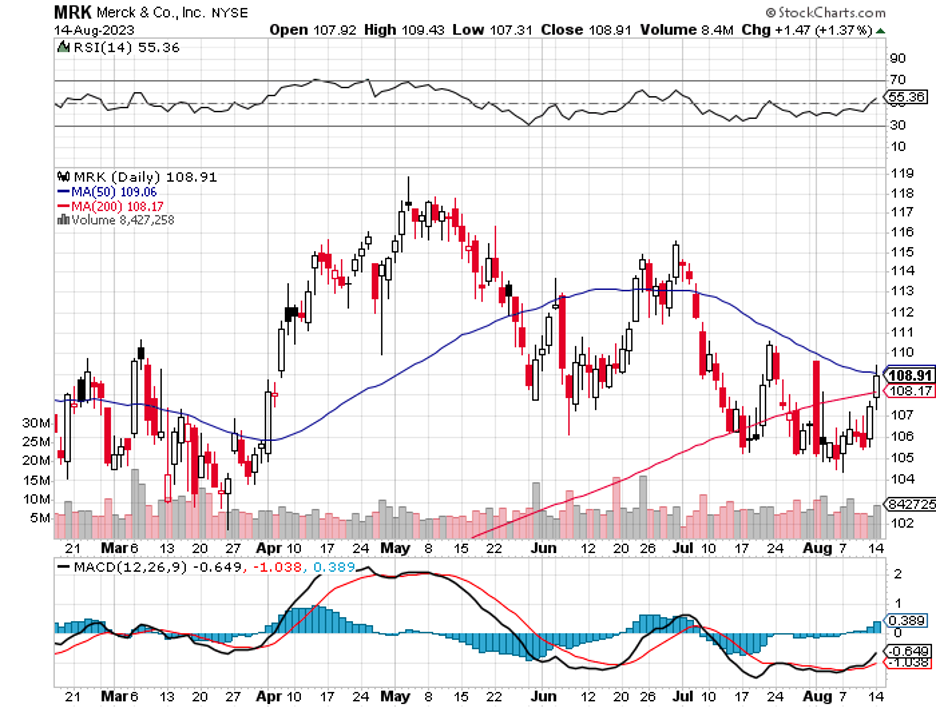Engaging in the pursuit of income through investing might not be the most riveting way to build wealth. Still, the story can unfold with remarkable profit when dividends remain consistent and occasionally serve as a side of growth.
Take a look at the captivating tale of Merck (MRK) shareholders. Picture this: a $5,000 investment made just five years ago that has now blossomed into $9,700 with dividends reinvested. An investment that beats the S&P 500 index's transformation of the same amount into $8,600 during that same stretch. Intrigued? You should be.
Now, let's dive deeper into this pharmaceutical marvel, a proud member of the Dow Jones Industrial Average.
Few players in the pharmaceutical landscape embrace innovation quite like Merck, an arena where it generously dispensed $13.5 billion on research and development in 2022.
That's a whopping 23% of its impressive $59.3 billion in total revenue for that year.
From the game-changing oncology drug Keytruda to the vital human papillomavirus vaccine Gardasil, Merck's pharmaceutical arsenal boasts seven products, each teetering on the brink of exceeding $1 billion in sales by 2023.
Emerging from its New Jersey hub, Merck's total sales displayed a modest 3% growth year-over-year, totaling $15 billion in Q2.
But factor in the robust U.S. dollar's foreign exchange influence, and you'll discover a currency-neutral surge of 7% for that quarter. A deep dive into these numbers would reveal an increase in sales in five out of seven of Merck's blockbuster products.
The spectrum of growth ranged from a modest 1% for its ProQuad/M-M-R II/Varivax vaccine franchise to a meteoric 53% for Gardasil.
Even the 30% and 23% YoY sales dips in diabetes medicines Januvia and Janumet couldn’t dim the sparkle, as generic competition in Europe and U.S. pricing challenges were handily offset.
The plot thickens with Merck's Q2 non-GAAP net loss per share of $2.06. Unravel this figure, and you’ll find that, excluding the $4.02 per share acquisition charge for Prometheus Biosciences, adjusted diluted EPS actually rose 4.8% YoY to $1.96.
Notably, the acquisition of Prometheus, a spotlight on immune-mediated disease treatments, fortifies Merck's immunology pipeline, adding the promising PRA-023 drug candidate for ulcerative colitis and Crohn's disease.
Merck's R&D treasure trove is far from empty.
With over 100 projects in phase 2 or phase 3 clinical trials, gems like the pulmonary arterial hypertension drug candidate sotatercept stand out, projected to reach annual peak sales of $3 billion to $4 billion.
Moreover, Merck's adjusted diluted EPS is projected to rise 9.4% annually for the next half-decade, outpacing the industry's 8.5% consensus.
Merck's 2.8% yield isn't just numbers on a page; it's a tantalizing promise, especially when juxtaposed against the S&P 500 index's 1.5% yield. And the intrigue deepens when you learn that Merck's quarterly dividend per share soared 52% higher in a mere five-year span.
Expect the threads of mid- to high-single-digit annual dividend growth to weave into the future, enabled by a strategic dividend payout ratio of just 41% for 2023, excluding the Prometheus acquisition charge. After all, the company has shown excellent strategies in terms of capitalization on growth opportunities and further fortification of the balance sheet.
With shares surging 21% higher in the past 12 months, Merck's momentum isn't just business—it's also in the stock. And yet, there's still more to be uncovered for income investors.
Consider Merck's forward P/E ratio of 12.4, a figure that ducks below the drug manufacturer industry average of 13.3. These numbers sketch a compelling picture where above-average growth potential meets below-average valuation. Analysts pencil in an average 12-month share price target of $125—a striking 19% upside from the current $105 share price.
In the grand tapestry of investment opportunities, Merck's stock elegantly stitches together an engaging and profitable narrative, making it an alluring buy for income investors at this juncture. It's not just a chapter in the book of investment—it's a whole saga waiting to be read.

